Our beloved cocker spaniel, Lana left us in February, 2023 at the age of 14 years 4 months. She was indescribably wonderful so I won't even try. Her loss was sudden after a slow decline, and we swore we would never have another dog. But of course we started looking. We wanted to stay local, rescue a pet and not contribute to the problem by going to a puppy mill out of state. Over and over we were told by every shelter, by the Pima Animal Care center and the Humane Society that cocker spaniels are never to be found in Arizona and especially not in southern Arizona. But David refused to give up. After registering with every pet adoption website, and after 30 or more emails to various shelters we finally found our new family member at a shelter in Gilbert, Arizona, a beautiful 3 year old cocker. We named him Smoopie because he is very affectionate. If you are a Seinfeld afficianado the name needs no explanation. If not, check out Seinfeld, Season 7, Episode 6 The Soup Nazi.
 copy.jpg)
Smoopie at 12 weeks, the first time he came to the shelter
Smoopie has a sad history. He came to the shelter as a stray from the Humane Society at 12 weeks. The shelter found him a home, but his humans proved to be so abusive that, after 3 years, the shelter had to get a court order to have him removed and returned to them. Just before that, they received David's email and replied that they almost never see cocker spaniels in Arizona. When Smoopie was returned they notified us right away and we drove immediatly to get him.
Smoopie after his first grooming with us
Smoopie being adorable
He's a wonderful boy, still loving and playful, even after all he's been through. But now he is home.
Since the pandemic hit, David has been devoting his time to teaching undergraduates, M.A. students and PhD. candidates along with guesting with other universities' student committees. In the school year 2022-2023 he taught more than 1400 students, and his international MOOC (outreach online lecture series) has reach more than 45000 people across the world. His research projects in Italy continue too. Currently, David is working with several of his former students to publish the second volume covering the excavations of the Roman villa and infant cemetery near Lugnano in Teverina. This includes preparing a comprehensive computer reconstruction of the villa and its environs, developing a video on life along the Tiber at the time of the construction of the villa about 30 BCE and preparing research to explain what might have been frightening the inhabitants of this area of Umbria that led them to bury their dead with many types of apotropaics to guard against malevolent forces after death. His fromer students David Pickel and Jordan Wilson are leading this project, while continuing their post-doctorate work at Georgetown and Penn State Universities respectively.
David and Noelle plan to return to Italy soon.
In June 2019 we decided to splurge and stay in an actual palazzo in the heart of Orvieto as a belated 50th anniversary gift to ourselves. It’s called the Palazzo Febei – 11 rooms, 2 baths 3 bedrooms – very luxurious.
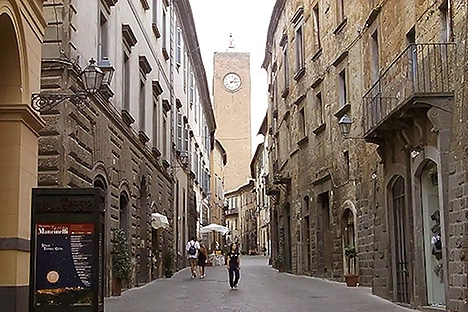 ......
......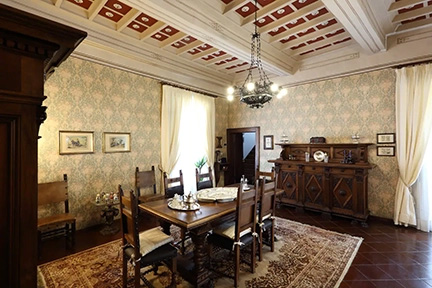
Just outside the palazzo on the Corso and its main dining room
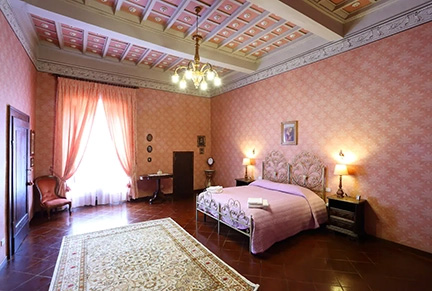 ............
............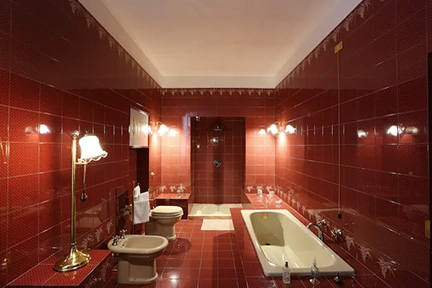
One of the three bedrooms and the main bath in the palazzo
We took the usual trips with the students to Rome, Florence, Perugia, and on our own the highlight was a trip to Nepi, the site on an ancient source of mineral water still bottled today. A truly picturesque town. And the source is located amongst Roman ruins that are still wild, unexplored and for the most part inaccessible.
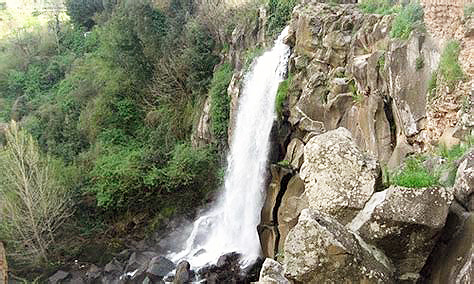 ............
............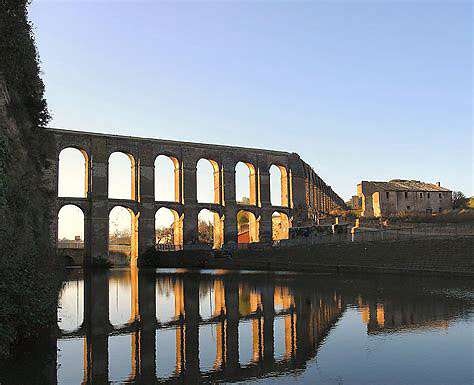
A waterfall and an ancient Roman acqueduct at Nepi
On the way we visited the ruins of ancient Ocriculum, a town noted for its badly eroded amphitheater and the visible remains of the famous Via Flamina that passed through here.
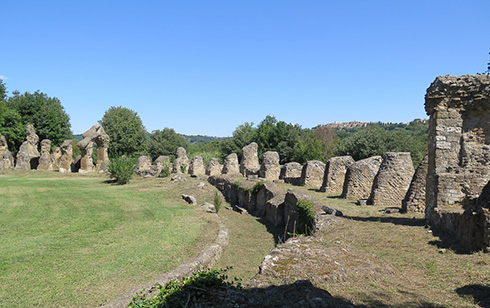 ........
........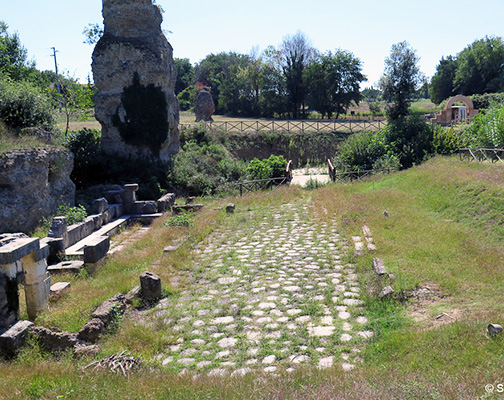
The remains of the amphitheater and the Via Flaminia
In June 2018 the archaeological team for which David is the Scientific Director and initiator had a successful season of excavation of an infant cemetery at Lugnano in Teverina in Umbria, Italy. The team excavated several burials among which was that of a ten year old boy who died of malaria that dates from the fifth century A.D. The child also exhibited evidence of dental abscesses. The pain from that, along with the malarial fever, would probably have made him seem possessed, according to beliefs of the time. He was buried with a large stone shoved into his mouth after death, apparently to keep the evil spirits within him that seemed to cause his distress from getting out into the world. Such a burial is known as a "vampire burial" because of similar methods used to keep the alleged living dead from wreaking havoc in medieval times.

The skull from the "vampire burial"
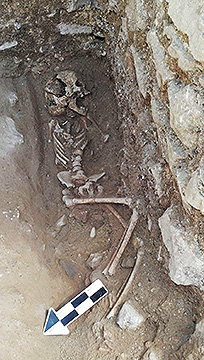
The vampire burial
The story of this discovery was written up by the University of Arizona as a press release and was immediately picked up by Sky News (Rupert Murdoch) in London. Within hours, the word of it, along with several photos we provided of the burial, had spread over the internet to over 1000 media sources. The story was the Number Two most covered story out of the University of Arizona in 2018, second only to the University's space probe and black hole photo stories.
In January 2018 David was given the Excellence in Undergraduate Teaching Award from the Archaeological Institute of America, the national organization for professional archaeologists. Quite an honor!!!
In 2017 David and Noelle celebrated their 50th wedding anniversary!

Each thought of a really original gift....but strangely they each came up with the same thing almost exactly!
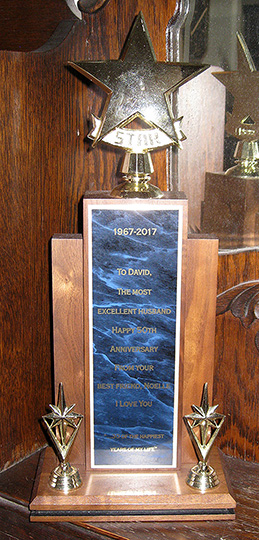 ..............................
..............................
Left - Noelle's gift to David (for 30 of the happiest years of her life..A JOKE!!) and
Right - David's gift to Noelle engraved from Sen. Bernie Sanders (also a JOKE!) These were purchased from different salesmen at the same store at different times, and NO - neither knew that the other had come up with this idea.
HAPPY ANNIVERSARY!!!!!!!!!!!
Toward the end of 2017 David was honored by the town of Lugnano in Teverina, in one of the most important olive producing areas of Italy, with an olive to be named after him.
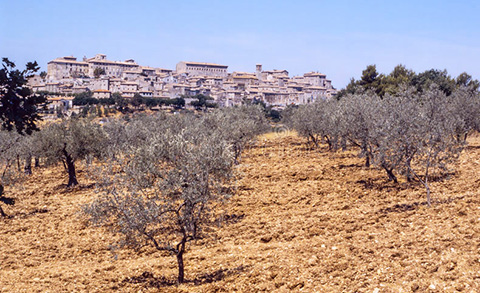 ......
......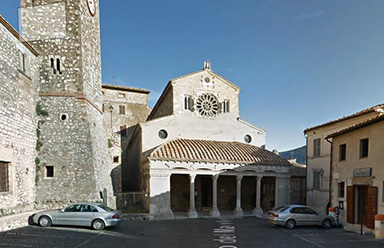
Left - the town of Lugnano in Teverina as a backdrop to one its famous olive groves
Right - the town square of Lugnano with the Collegiate Church of Santa Maria Assunta (11th-early 12th century)
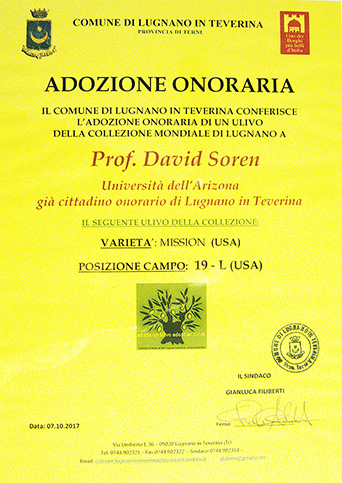
The award.
The olive will hit the market in 3-5 years when it will officially be named after David.
Our trip to Orvieto in 2017 was highlighted by another wonderful trip to Rome with the students of the Orvieto Institute. We visited the Forum and the Palatine and then a few of us went for a delicious lunch at one of our favorite restaurants, Massenzio, right near the Forum Transitorium.
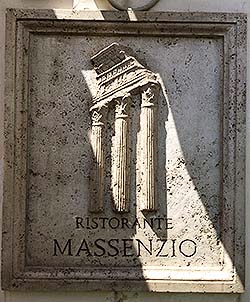 .......
.......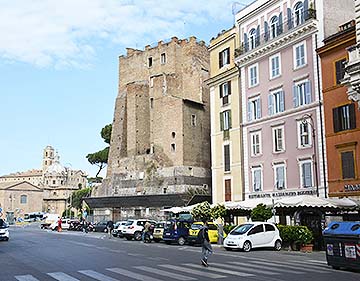 .......
.......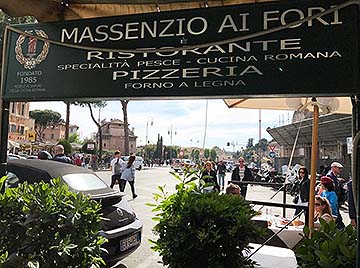
The Massenzio is the pink building on the right, just next to the east side of the Forum Transitorium on the left. The view on the right shows how close the restaurant is to the east side of the Forum Romanum.
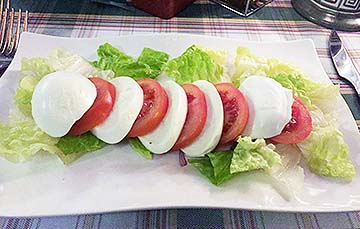 ......
......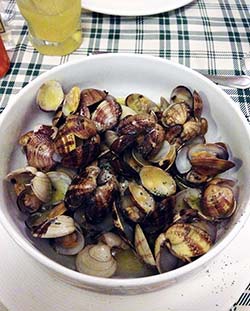 ......
......
Some specialties, left to right: Insalata Caprese, Vongole and Spaghetti ala Carbonara.
We also took a trip down the coast to Sperlonga, the site of the fabulous Grotto of Tiberius (Roman Emperor 14-37 CE) and the famous Sperlonga Museum housing the sculptures from the grotto.
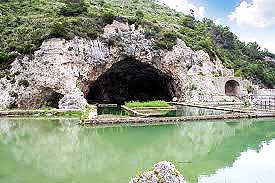 .....
.....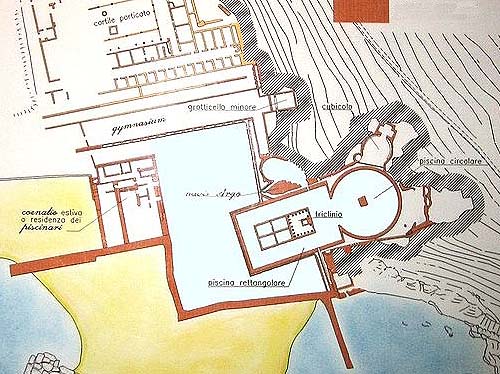
The grotto (left and the circular structure on the plan at right)
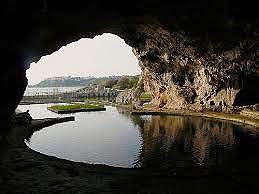 .....
.....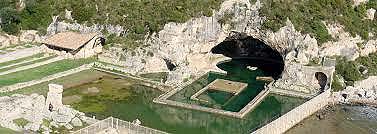
(Left) A view of the circular pool inside the grotto and (Right) an aerial view of the complex.
The grotto was part of a much larger villa complex on the sea at Sperlonga where several famous sculptures, discoverd in 1957 and now housed in the museum, have been found: these include the portrayal of the assault of Scylla on Odysseus' ship, the blinding of Polyphemus, the theft of the Palladium, and Odysseus lifting the corpse of Achilles all in the Hellenistic Baroque style. The works have been attributed to Rhodian sculptors Agesander, Athenodorus and Polydorus.
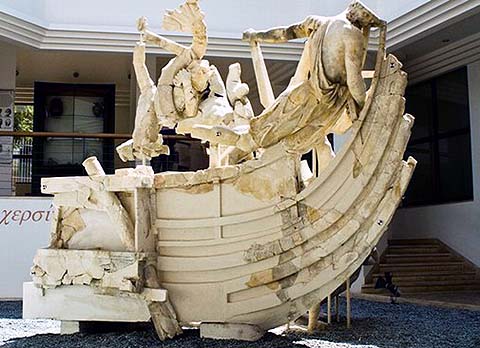 ....
....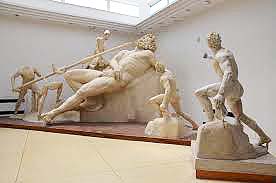 .....
.....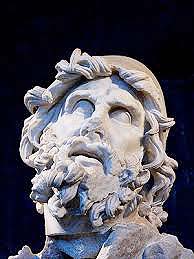
(Left) The Scylla group (Center) The blinding of Polyphemus (Right) A head of Odysseus, all in the Sperlonga Museum
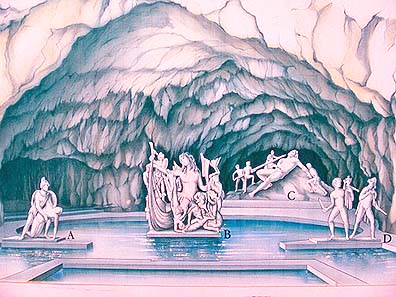
A proposal for the original arrangement of the sculptures within the grotto with the Scylla group at the center
Just down the coast at the town of Gaeta we had a lovely lunch at the Ristorante Agostino on the beach...
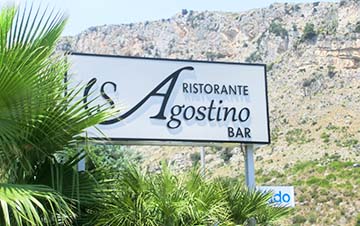 ....
....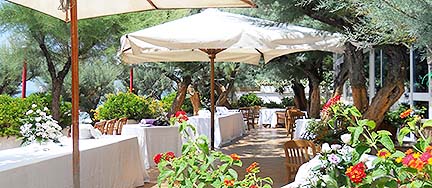
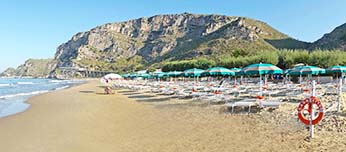
Some scenes from the Agostino
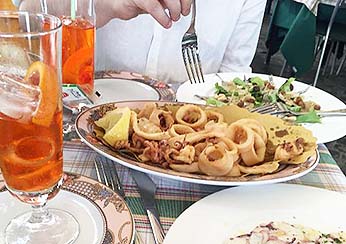 .......
.......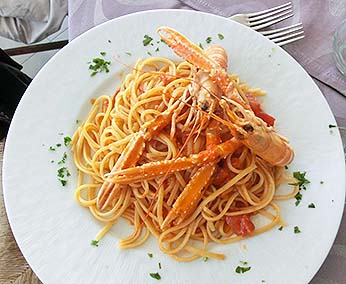
Some delicious dishes from the Agostino - (Left) Calamari with a spritz and (Right) Linguini agli Scampi
In April, 2017 Rick Polizzi, Producer and Animation Supervisor of the TV show The Simpsons came to the University of Arizona to take over David's art history and cinema class by giving a one hour lecture on the making of the television show. Rick is responsible for, among many other things, the opening couch humor sequences that begin the show.
Rick has been with the show for 16 years and has personally won three Emmy Awards for his work on the show. Rick and his wife Carla and daughter Bryce, a student in David’s class, celebrated their 29th wedding anniversary with the 400 students of David's class. After class, students and faculty took the Polizzi’s to lunch at a local restaurant, Wilco's, where the owner turned out to be a big Simpson fan! (Photos by Sandra Bernal)
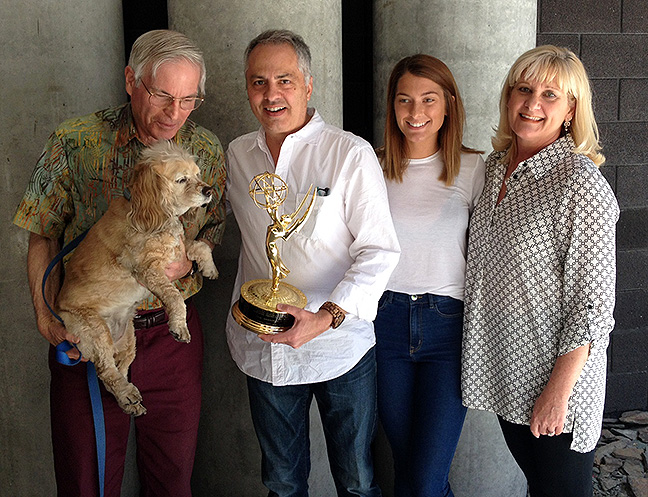
David and Lana, Rick with Emmy, daughter Bryce and wife Carla
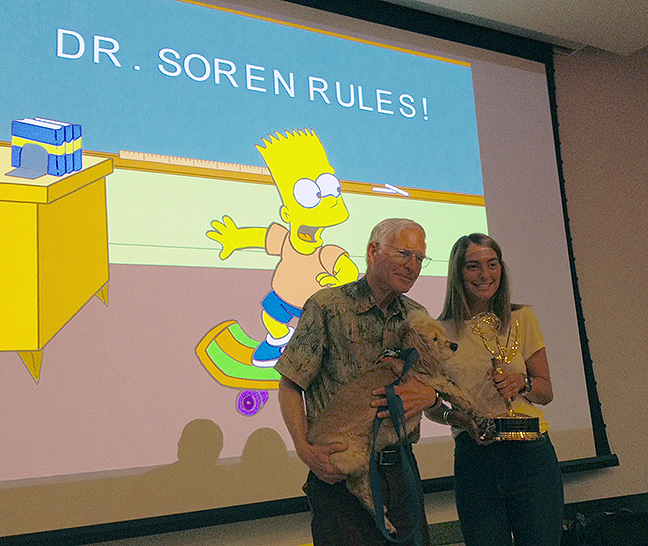
David and Lana with Bryce and Emmy in front of a special surprise tribute from Bart Simpson himself to Dr. Soren and his class
In February, 2017 David hosted the presentation of the Distinguished Lifetime Achievement Award for the Humanities for 2017 to Joe and Justine Medeiros who had released their movie Mona Lisa is Missing, an award-winning documentary about the 1911 theft of the painting from the Louvre Museum in Paris and of the story of its recovery in 1913. Joe is the former head writer for the Jay Leno Tonight Show for 22 years and director of the Mona Lisa documentary. (Photos by Sandra Bernal)
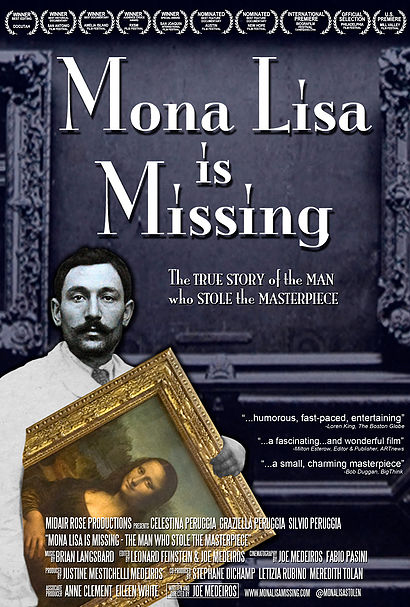
Poster for Mona Lisa Is Missing
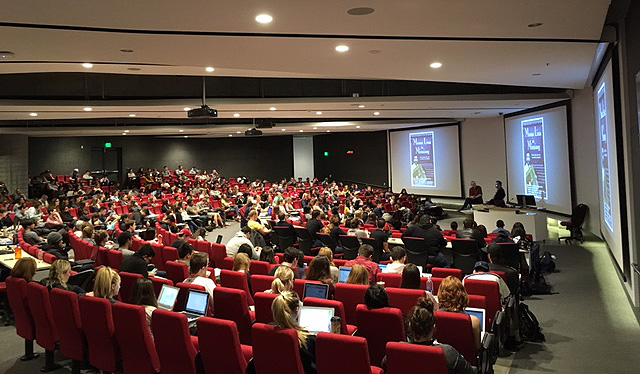
David and Joe Medeiros holding class
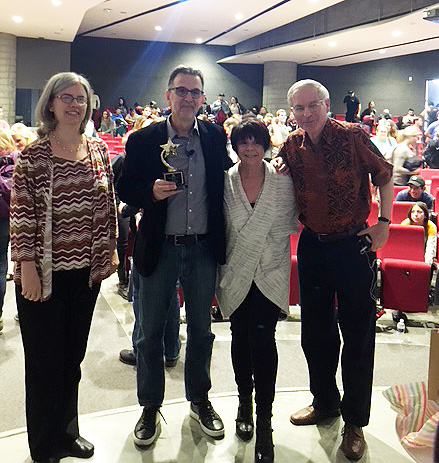
Karen Seat Associate Dean, College of Humanities, Joe with his Lifetime Achievement Award, Justine and David
Our 2016 trip to Orvieto was highlighted by our stay in a beautiful apartment right in the heart of Orvieto, owned by our friend Alba Frascarelli. You can stay there too – its on Airbnb !
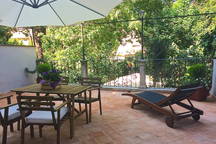 ..............
..............
(L)Our lovely patio and (R) livingroom
We began our stay with a day to wander in Rome to sites tourists often skip..always a treat...our first stop was the little church of San Nicola in Carcere that sits atop three Republican Roman temples in the ancient Forum Holitorium by the Tiber.
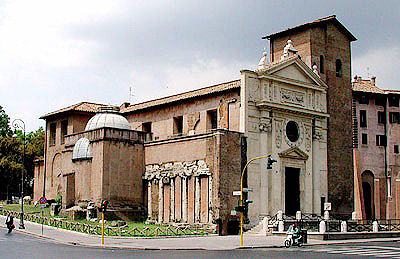 .........
.........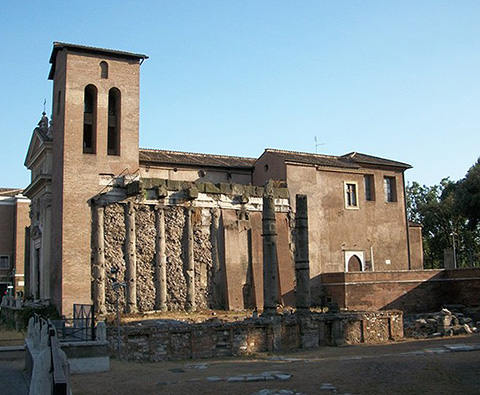
(L) East side of the church with Doric columns remaining from the Temple of Spes (R) West side with columns remaining from the Ionic Temple of Janus.
The central Ionic Temple of Juno Sospita became the body of the church. (See reconstructions below)
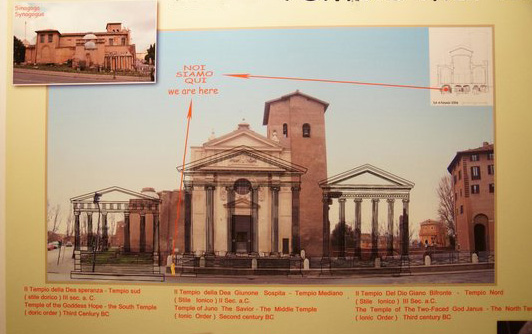 ......
......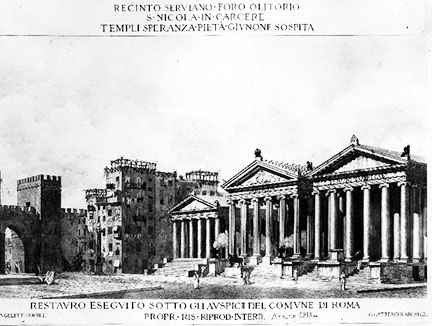
Under the church you can see the foundations and remains of these temples more closely (ask the custodian for the key)
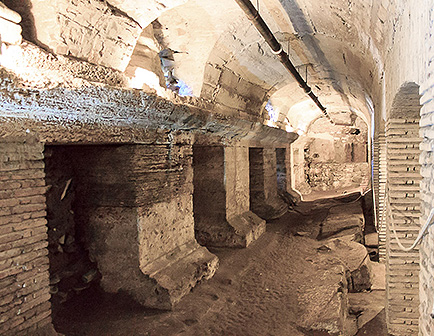 .....
.....
Below San Nicola in Carcere, the foundation of the Temple of Juno Sospita
From there we walked to the Republican Temples of the Largo Argentina, the Pantheon, the Temple of Hadrian, the Column of Marcus Aurelius...
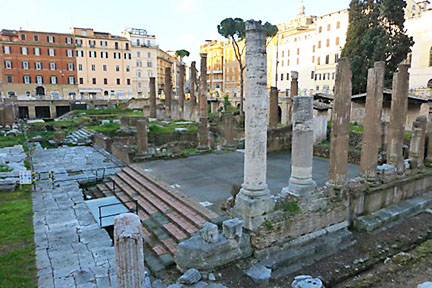 .......
.......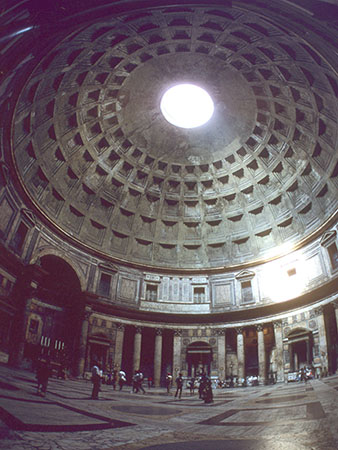
(L) Part of the temple complex in the Largo Argentina (R) Interior of the Pantheon
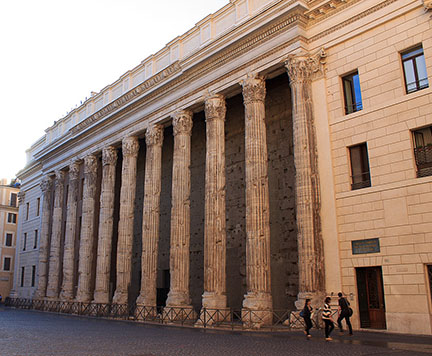
The surviving colonnade of the Temple of Hadrian in the Piazza di Pietra...
and then we stopped for a break at my favorite store - Alviero Martini Prima Classe on the Via Frattina...
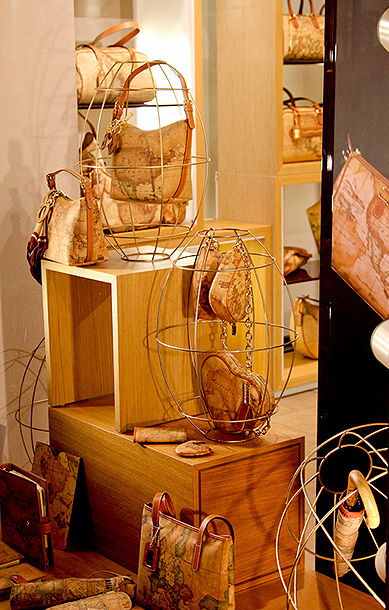 ........
........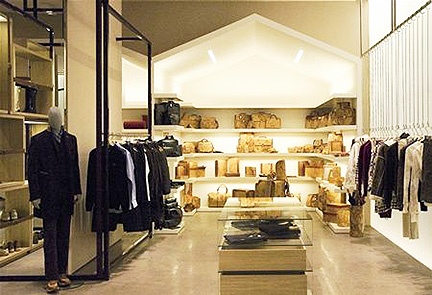
The Prima Classe line from Alviero Martini is characterized by colorful world maps on luggage, clothing, purses, shoes and just about anything else you can think of...
From here we headed west to the Piazza Navona built on the ruins of the Stadium of Domitian where we discovered that the extensive ruins of the stadium below the piazza have been opened to the public.
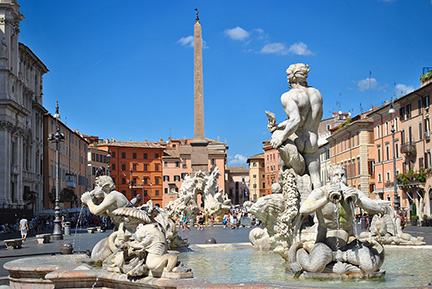 ..........
..........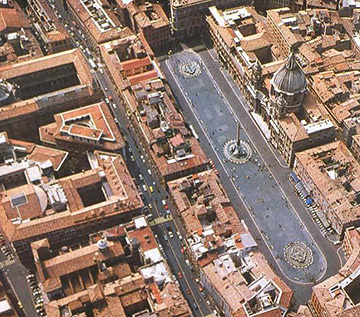
The Piazza Navona on the ground (L) and from the air...
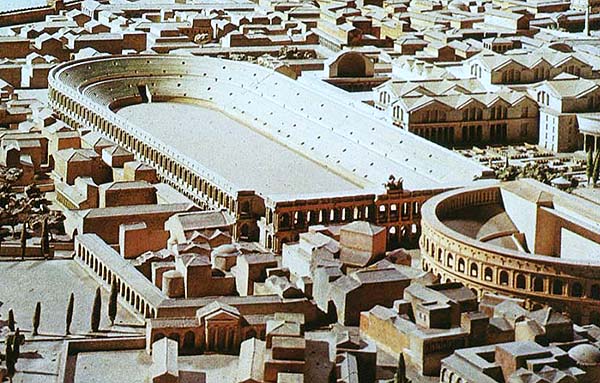
And its appearance in reconstruction...
..........
Below street level the ruins of the stadium can now be visited...
For lunch we stopped at the Hostaria Costanza near the Campo dei Fiori, built into the ruins of the Theater of Pompey. You can see the ruins while you eat in the dining room. You can read about this great restaurant here.
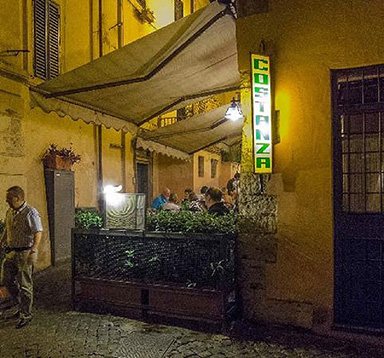 .........
.........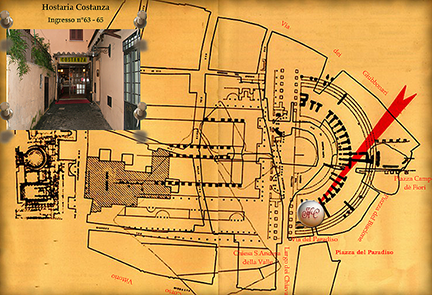
(L) The front of the Costanza and (R) The location of it in the ruins of the Theater of Pompey
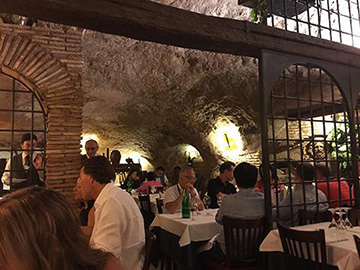
Eating in the ruins of the theater....
After lunch we strolled through the Campus Martius, past the Porticus Octaviae and the Temple of Apollo to the Capitoline Museum for a quick look at the goodies inside, and I took yet another picture of David with the giant head of Constantine...
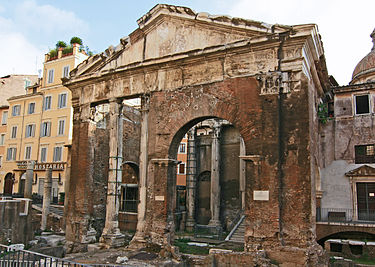
The remains of the Porticus Octaviae...
David and Constantine in 2016....
A couple of weeks later we went for the day to Tivoli...always a treat..to see the Villa of Hadrian, the Villa D'Este and to eat at the fabulous Sibilla Restaurant, built into the remains of two temples...
...
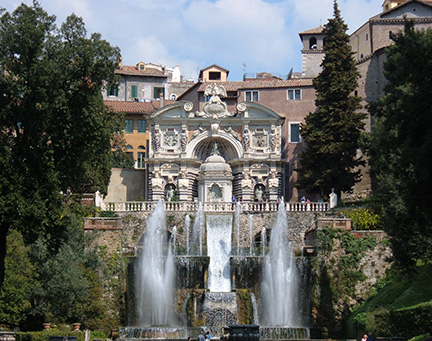
(L)The Canopus, one of the lovely sections of the Villa of Hadrian (R) A view of the gardens of the Villa D'Este
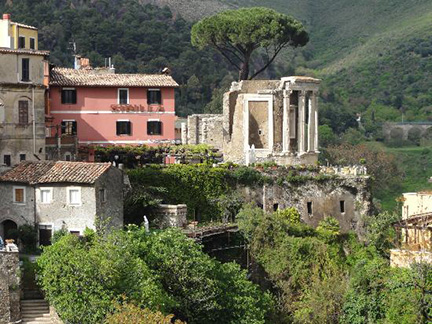 ........
........
The Sibilla Restaurant by the ruins of the Temple of Vesta and the Sanctuary of the Sibyl...
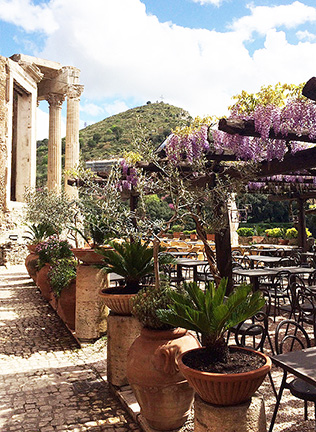 ........
........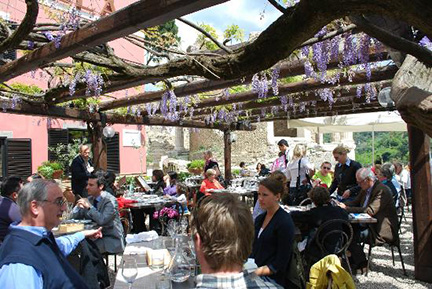
Inside the restaurant gardens by the ruins...
A special weekend trip for the group included the ruins of Pompeii and Paestum, the Naples National Archaeological Museum, a mozzarella factory in Paestum and the magnificent Royal Palace of the Bourbons at Caserta....
 ..............
..............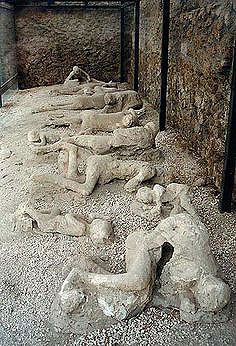
(L) A view of Vesuvius over the Forum at Pompeii (R) Plaster casts of cavities left by bodies covered with ash after the blast of Vesuvius
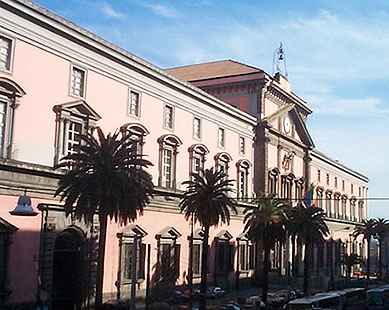 ..........
..........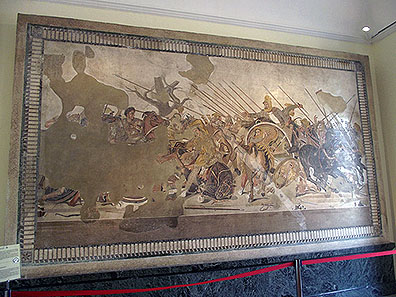
(L) The Naples Museum (R) The Alexander Mosaic in the Museum showing the battle of Issus between Alexander the Great and Darius III of Persia from the House of the Faun at Pompeii
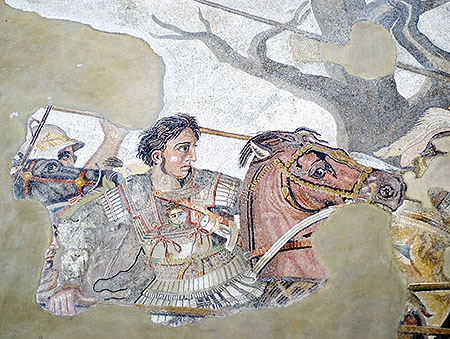
Detail of the Alexander Mosaic showing Alexander the Great
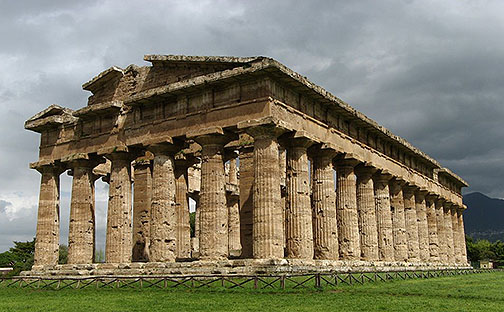 ..................
..................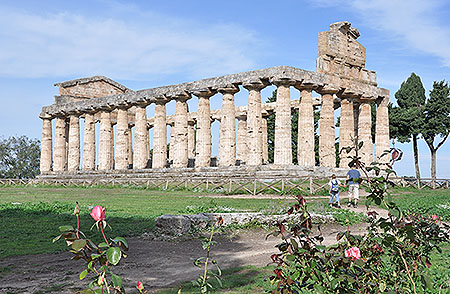
Temples at the archaeological site of Paestum (L) Temple of Hera 460-450 BCE (R) Temple of Athena 500 BCE
In the modern town of Paestum the group visited a mozzarella factory and buffalo farm to see how it all is done.
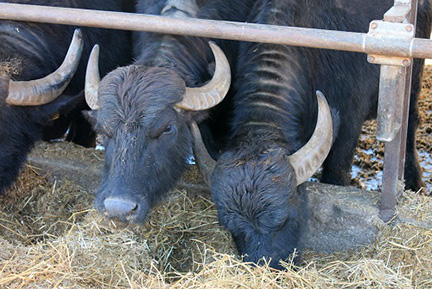 .......
.......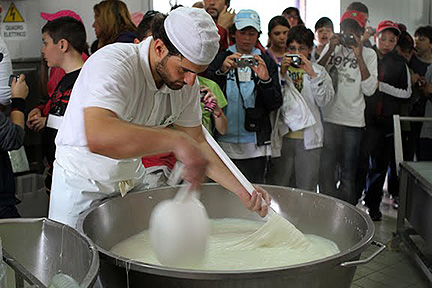 ......
......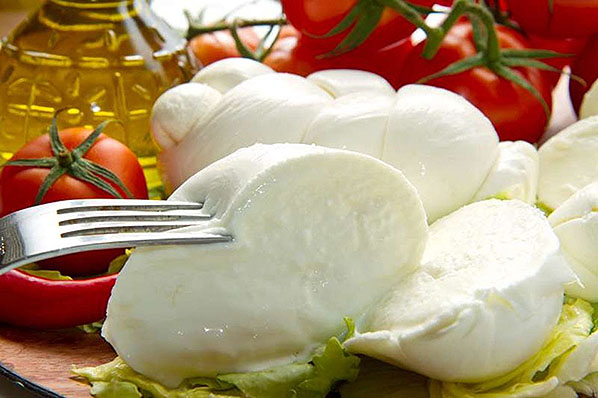
(L) Some of the buffalo (water buffalo) at the farm (M) Making the mozzarella (R) Yummmmmm
The Royal Palace at Caserta is listed as a UNESCO World Heritage Site. The palace was created in the 18th century by the Italian architect Luigi Vanvitelli as a Versailles-like residence for the Bourbon kings of Naples and Sicily. Inside are more than 1200 rooms, decorated in various styles. The park is 2 miles (3.2 km) long and contains many waterfalls, lakes and gardens, as well as a very famous English Garden
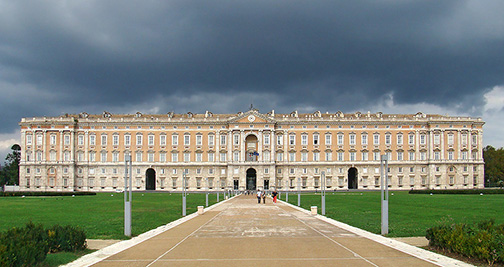 ........
........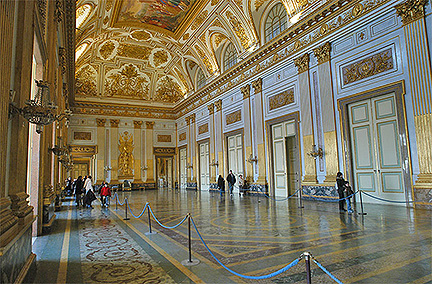
Some views of the Royal Palace at Caserta (L) the facade (R) the Throne Room (Lower L) the Royal Gardens (Lower R) the Bath of Venus in the English Garden
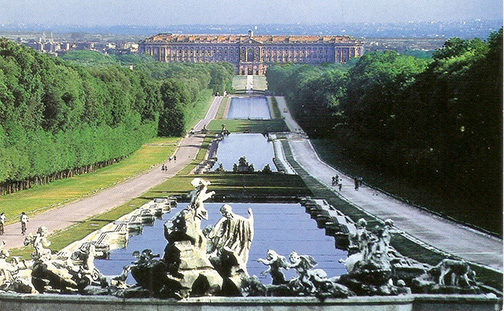 ..........
..........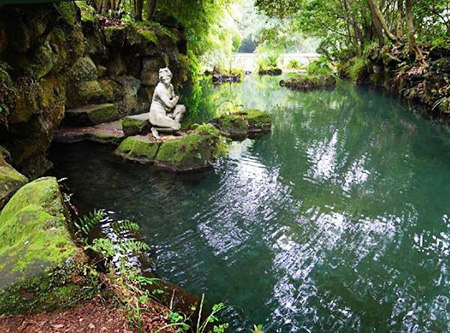
In 2016 David was invited by the town of Lugnano in Teverina to continue a dig there we had left 24 years ago.
At that time (1994) David had left some of the infant cemetery undug in the hopes that technology of the future would enable another archaeologist to discover additional information from any burials that might remain in addition to the 49 we discovered at the time. He had no idea he would still be involved after all those years! You can read about our work there in A Roman Villa and Late Roman Cemetery at Poggio Gramignano, Lugnano in Teverina Italy, L'Erma Bretschneider (1998). This summer we visited the site again in preparation for the dig which began on June 25. In charge of the dig is David Pickel, a graduate student from University of Arizona and Stanford University. His staff includes Melanie Zelikowsky (Registrar), Dr. Jamie Inwood (Bioarchaeologist with special training in Malariology) from Yale University, Prof. Veronica Tamorri (specialist in Infancy in Antiquity at the University of Durham), Skyler Jenkins (Conservator at the Arizona State Museum), as well as several students from the University of Arizona and Yale University.
While we were there Rai2-TV, a national Italian TV network, came and did an interview with David about the new dig. There is a link to see the video below.
........
(L) The countryside around the site at Poggio Gramignano (R) Part of the area left undug for the future where the new dig will be done
David being filmed and interviewed for Rai2-TV


On May 28, 2015 David was honored by the Italian hill town of Lugnano in Teverina for his archaeological work and his creation of an Antiquarium for this Umbrian town. (Photos By Prof. Kim Newton, University of Arizona)
The symposium was held in the comune or official meeting hall of the town and scholars spoke generally about David's theories regarding the spread of malaria in this area of Italy which he expressed some 25 years ago and their own interpretations and scientific progress since then.
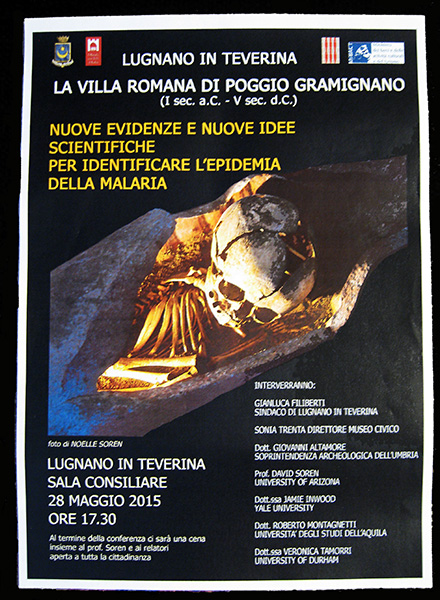
Included were Professor Veronica Tamorri of the University of Durham in England, Dr. Jamie Inwood of the Bioanthropology Program and Anthropology Department of Yale University, and Dr. Roberto Montagnetti, the community archaeologist for the area. Roberto had come to David's dig as a five year old and played in a little area David would make for little kids. That was where Roberto's interest in archaeology began!
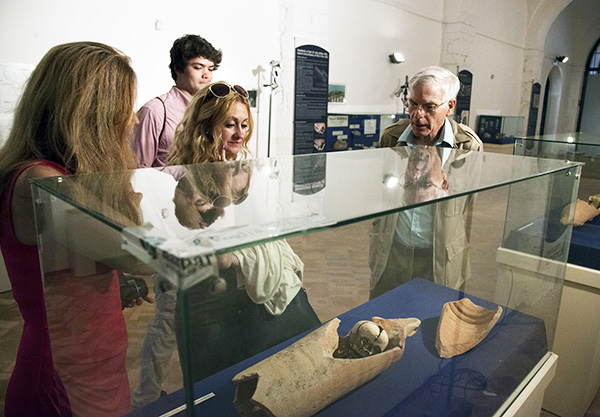 .....
.....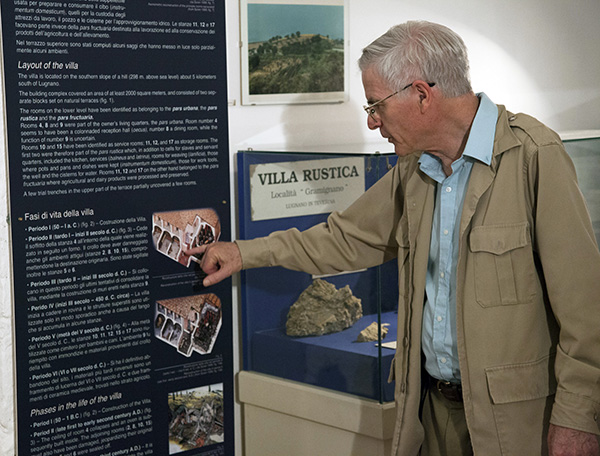
Left - David is explaining one of the well-known infant burials from Lugnano, reconstructed in the museum, to Dr. Jamie Inwood and her Mom. Right - David explains the phases of the Villa Rustica that we dug near Lugnano in the 1980s.
Following the symposium the Mayor of Lugnano in Teverina, Gianluca Filiberti, and Sonia Trenta, director of the local Antiquarium spoke, thanking David for his contributions to the town of Lugnano.
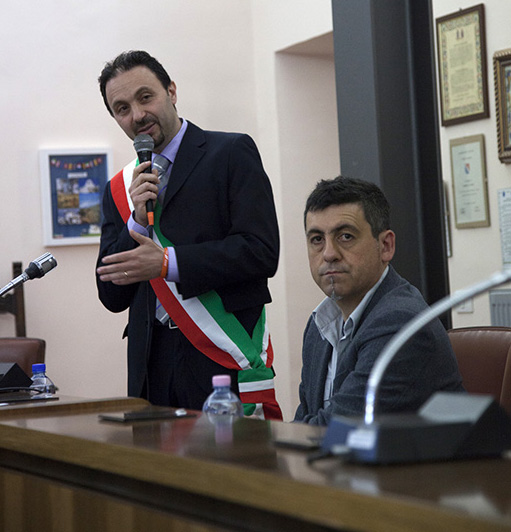 .......
.......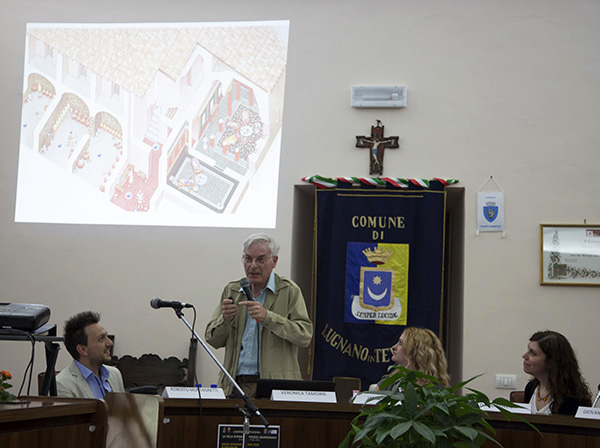
Left - The Mayor of Lugnano and his assistant. Right - David speaking at the Symposium
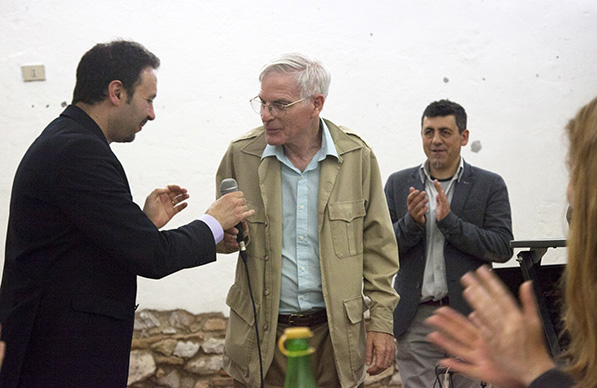
David and the Mayor of Lugnano
This was followed by a public dinner held at the Town Hall. More than 125 people attended and the event was filmed and presented on the Umbrian Regional News Program on RAI-1 television in a 2 minute segment. The local government also announced that they were initiating plans to develop a project with David in cooperation with Dr. Inwood and Yale University for the study of malaria victims and the augmentation of the local museum next summer.
In April, 2015 David invited for an interview
in his Art History of the Cinema class the action film star Brad Harris. The 3 day program included a tribute to Brad's life and work in film
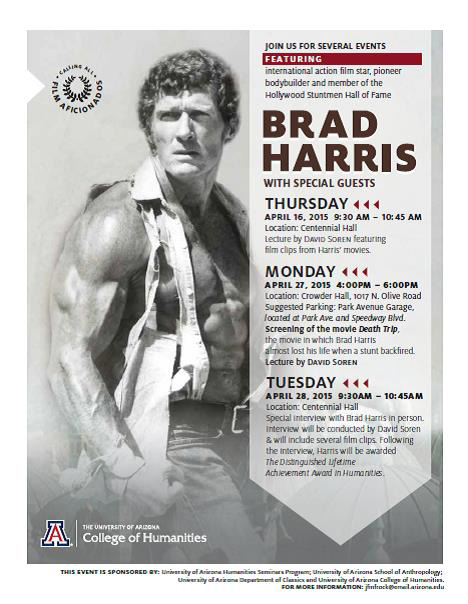 ......
...... .....
.....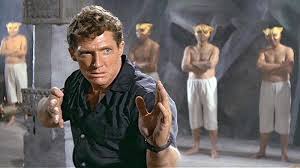
The class included a showing of one of our favorite Brad films, Kommissar X Halts the LSD, also called Kommissar X and the 3 Green Dogs that we first saw while working in Tunisia in the 1970s. Its a great action film with amazing stunts by Brad and Tony Kendall all set in Istanbul and Goreme, Turkey.
.....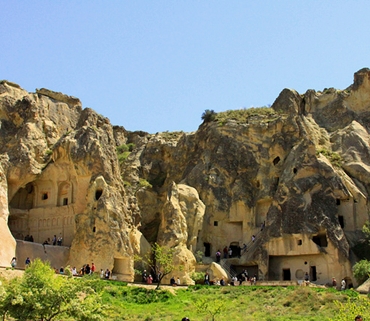 .
..
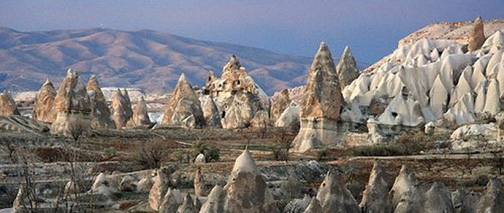
Center-a poster from Kommissar X Halts the LSD (1967)
Left and Right-the Goreme Open Air Musem where the action climax of the film was shot
Brad Harris was one of the most famous stars of sword and sandal films of the 1960s playing gladiators, Samson, Goliath, Hercules and other Greek and Roman roles. He was the husband of cult film star Olinka Berova, most known for her starring role in Vengeance of She, the successor to She with Ursula Andress. Brad went on to diversify himself by starring some 10 times with Italian actor/friend Tony Kendall (real name Luciano Stella) in westerns and secret agent films.
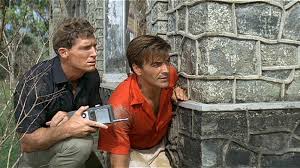 ........
........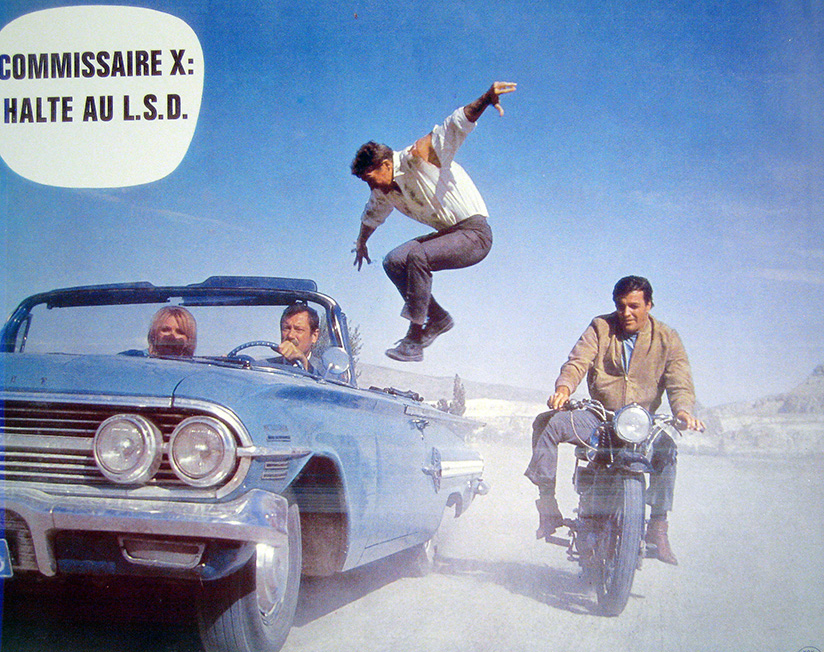
Brad and Tony Kendall in scenes from their Eurospy movies where they performed many incredible stunts like that on the right. Brad is jumping from a speeding motorcycle driven by Tony into a speeding car.
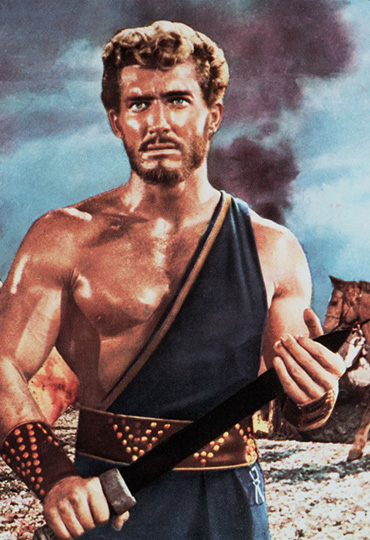
Brad as Goliath in Goliath Against the Giants (1961)
Between 1965 and 1971 they made 7 films in the Kommissar X series of Eurospy pictures. Among his other starring roles were turns in spaghetti westerns and even German westerns, The Three Fantastic Supermen, erotic sword and sandal films such as the Hot Nights of Poppaea, Lady Dracula with Stephen Boyd, The Mad Butcher with Victor Buono, and about 65 more.
The Kommissar X films became enormously popular all over the Third World and the 7 film series still sells in a deluxe box set in Germany. In them, Brad played New York Police Captain Tom Rowland opposite Tony Kendall as New York detective Joe Walker, known as Kommissar X. In the Third World on the Arab street in those days they both became important symbols of American justice in the good sense that perservered and always triumphed in the end. The Tunisian film audiences never failed to stand, cheer and woop at the end of these films. In this way Brad and Tony (even though Tony was in reality Italian!) were important to the image of the USA in a part of the world that knew little of life in America.
Brad is also a pioneer bodybuilder and the father of Sabrina Calley, the wonderful designer of numerous film costumes for many superstars including principally Angelina Jolie and Charlize Theron. She is married to producer Rick Porras, known for the Lord of the Ring Trilogy, Death Becomes Her and Forrest Gump. In all, it is quite a family of movie royalty. Brad, now 81, was a gracious guest and spoke at length about his life in film.
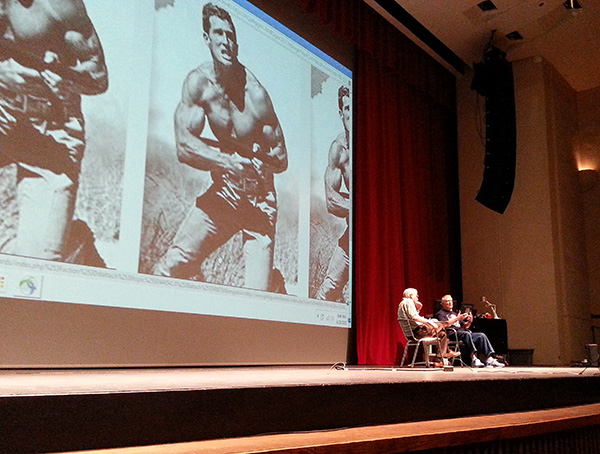 ........
........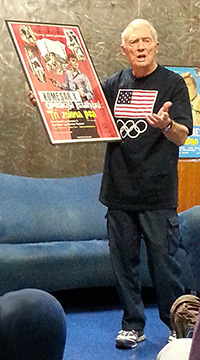 ........
........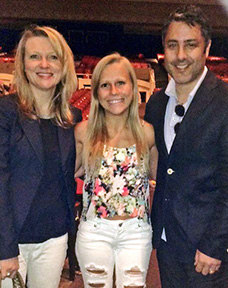
Left -David interviewing Brad on stage at Centennial Hall at the University of Arizona
Center - Brad discussing his Kommissar X movies
Right - Sabrina Calley, Brad's daughter and her spouse, film producer Rick Porras flanking Lynn Broussard, one of David's former students
The highlight of the occasion was the presentation to Brad of the Distinguished Lifetime Achievement Award in the Humanites from the Classics Department of the University of Arizona.
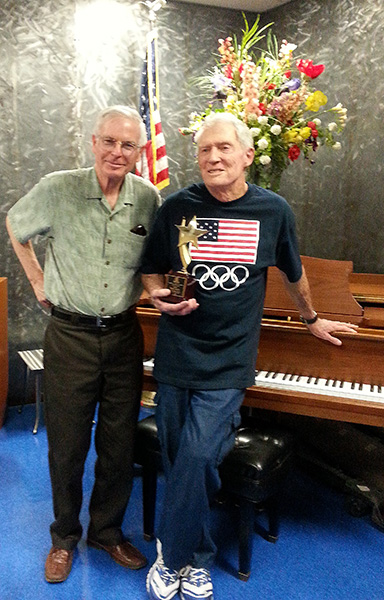
David and Brad with his new award
In 2014 our stay in Orvieto was highlighted by our 4 story apartment in the historic Palazzo Fillipeschi-Simoncelli, located on the Via Malabranca in one of the most picturesque quarters of the town. The 15th century palazzo is built over another historic dwelling of the 12-14th century and it is thought that the restoration was completed by Bernardo Rossellino, a well known Italian architect of that period whose style is echoed in the facade, loggia and portal of this building. The spacious interiors are highlighted by well-known frescoes of the 18th and 19th centuries. Among the famous guests who have stayed in this the Palazzo is Catherine de Medici, who would soon become the Queen of France, who visited Orvieto in 1532.
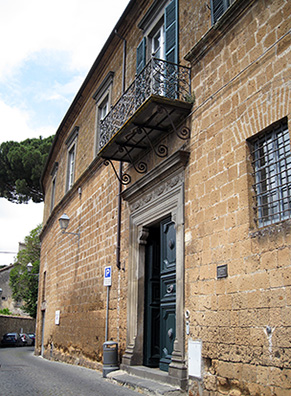 ...
...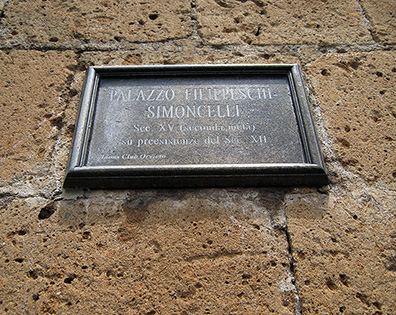 ...
...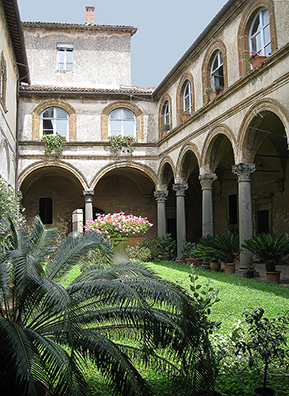
This year David moved into a new office at the University. It includes 3 rooms: a foyer that had been used for storage, a large main room and a small office to the east for a desk and a few bookcases. The main room had been remodeled in the 1960's to accommodate a mainframe computer and because of the noise all the walls had been covered with acoustical tile - the kind with the little holes. (See Mad Men Season 7 Episodes 4-5 for an idea of the effect of the incessant noise of these large computers on office workers). Since the 80's it had served as an office and storage room. The acoustical tile had to be ripped off and the walls replastered and painted. The floor had to be stripped and buffed several times and the room redecorated. University personnel took care of the stripping, plastering and painting, but Noelle was put in charge of the layout, color selection, furnishing and redecorating plan. Here are the results. We had a tiny budget and all of the furniture is second hand.
The office is entered through a foyer or anteroom. It was full of shelves and storage with a narrow path between shelves that led to the door of the main room. I also had some custom posters made for the walls like this one. I wish I had a before picture of this but here is the after picture.
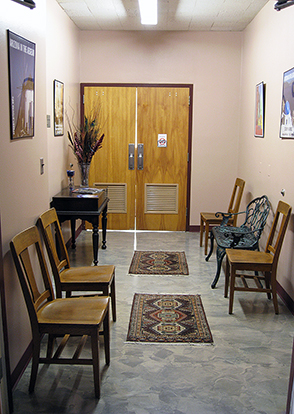 ...
...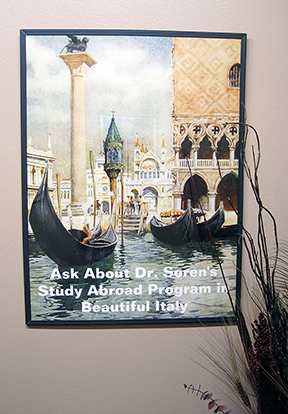
The view from the entrance of the main room looking south, before...
 ..
..
... and after
View of the southeast corner, south wall and southwest corner
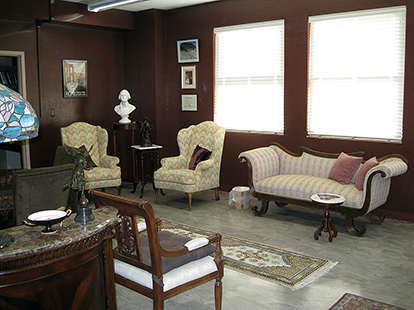 ..
..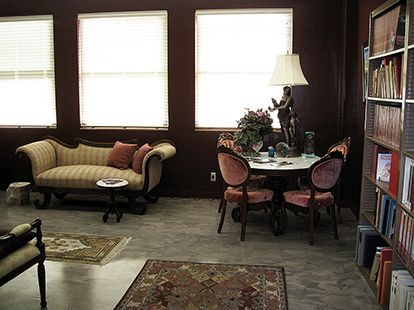
Southeast corner before and after...
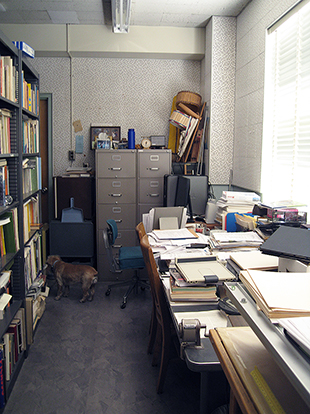 ...
...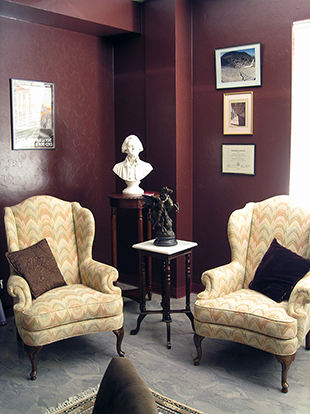
View to west toward entry with Dr. Soren and Lana (before view was not possible due to bookcases blocking it) and detail of southwest corner
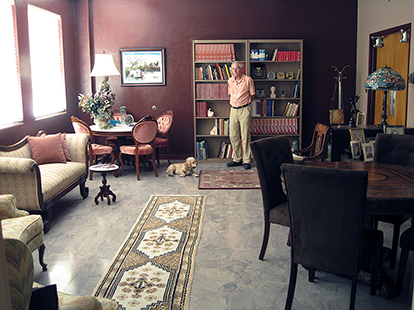 ...
...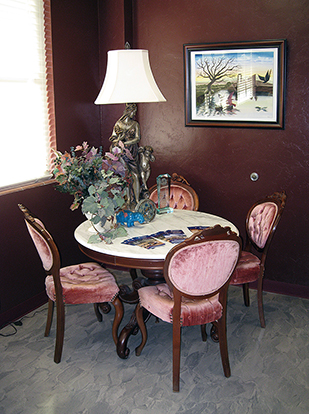
View to the northwest of entry...
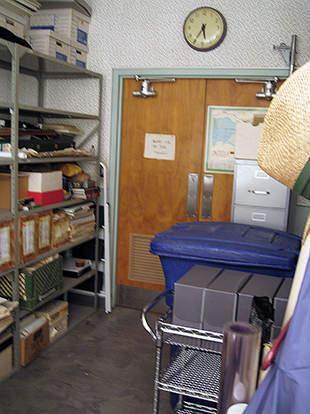 ...
...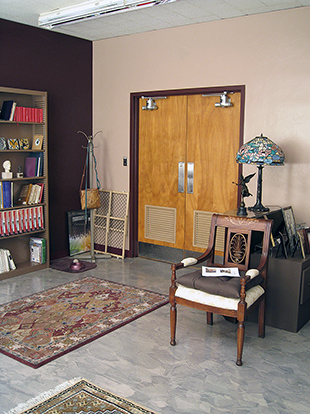
To northwest against north wall...
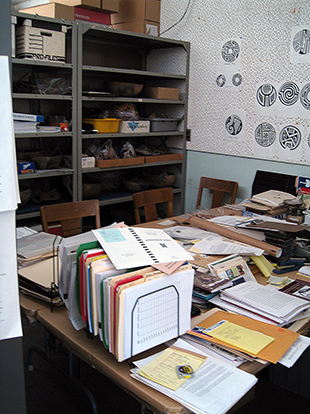 ..
..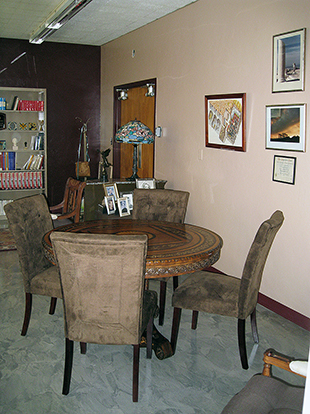
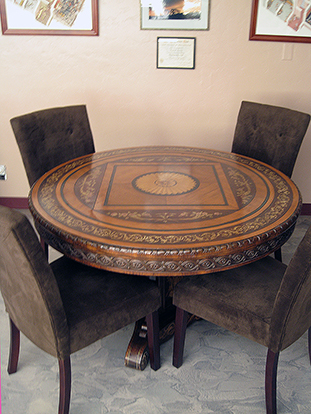 ..
..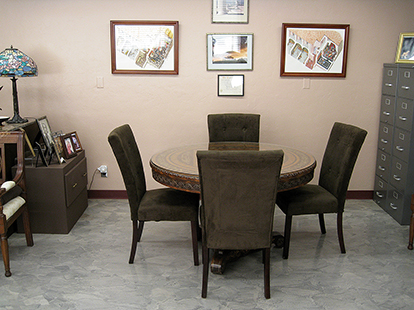
To northest corner (small back office is to the right)...
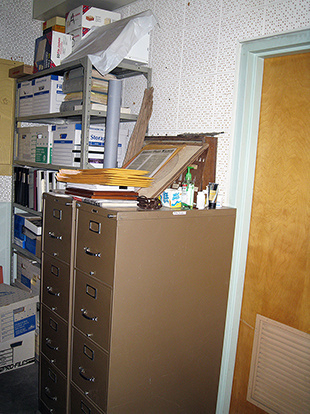 ...
...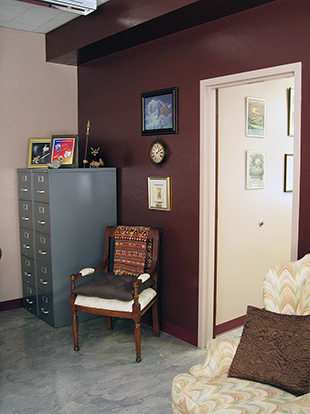
Small back office
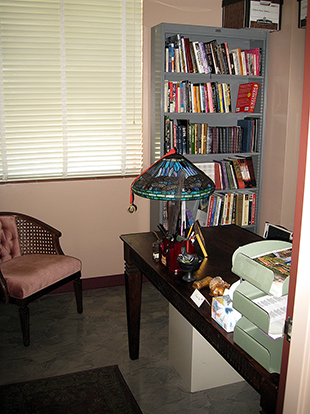

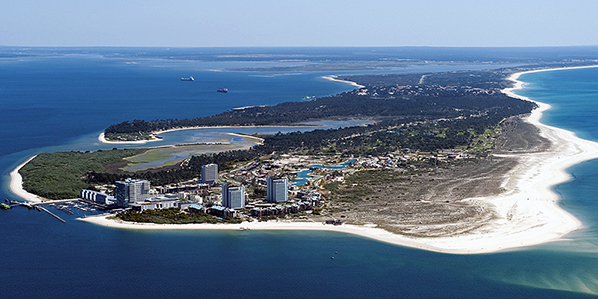
Troia Resort
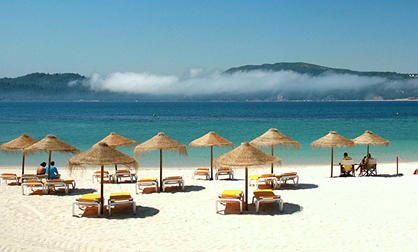 .
.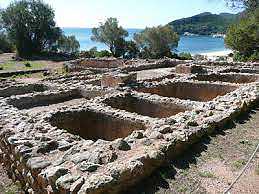
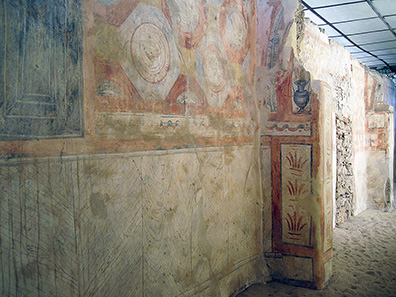
The beautiful beachfront at Troia, a view over the ancient fish sauce (garum) factory
The gorgeous Aqualuz Suite Hotel at the Troia Resort where the excavation is centered offers the students use of their facilities. Below are views of the main hotel and swimming pool.
...
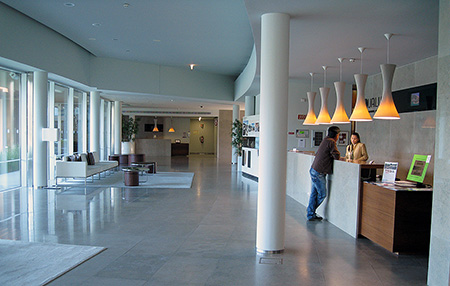
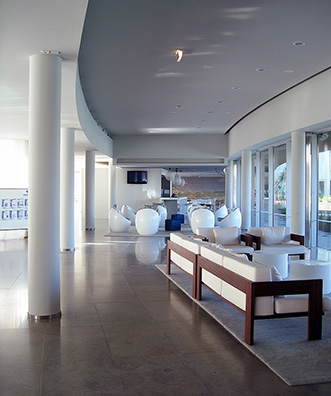 ...
...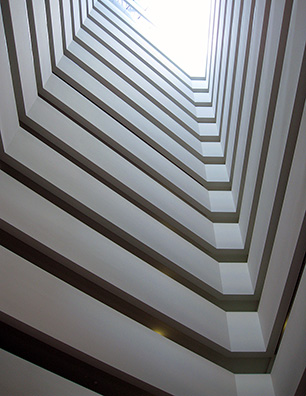
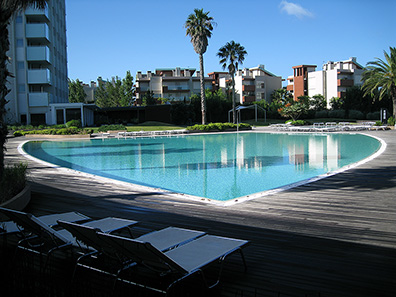
The resort is a huge complex with condos, apartments, private homes, shopping, restaurants, golfing and a casino. The marina and harbor hold private yachts, fishing boats and catamarans that provide dolfin watches off the coast for tourists.
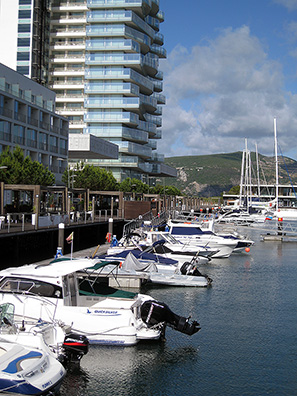
The students actually live in condos a short distance from the hotel. Each condo sleeps 4 with full kitchen facilities.
...
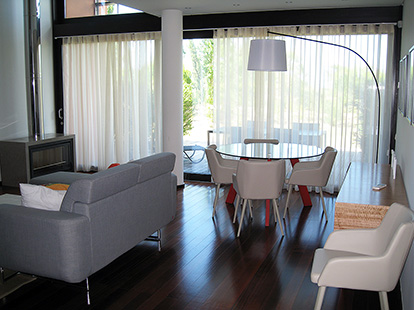
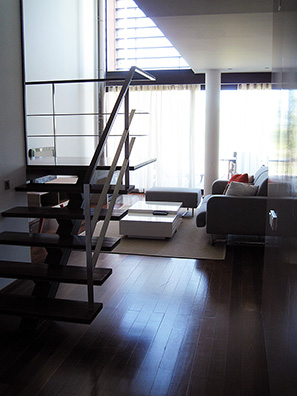 ...
...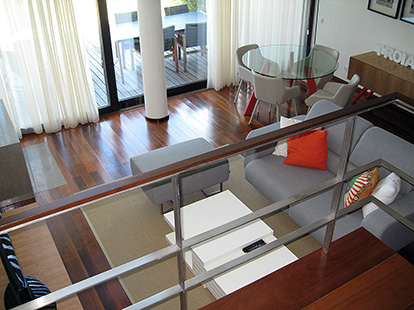
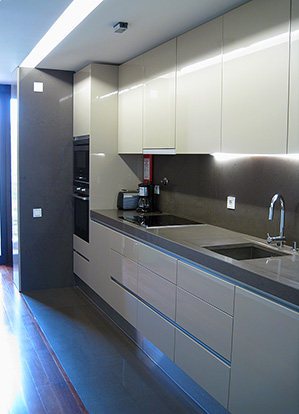 ...
...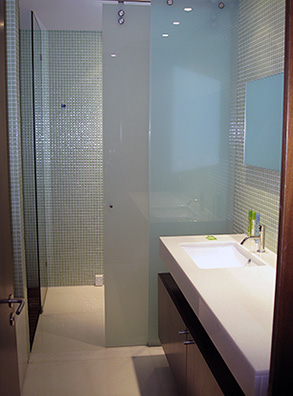
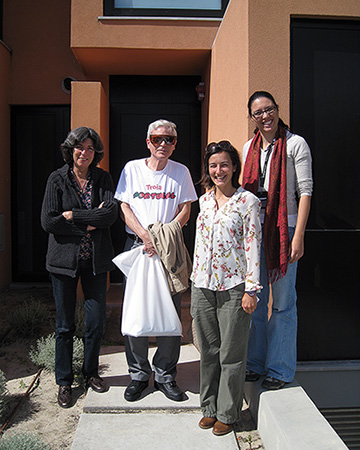
David with Ines Vaz Pinto, Director of Excavations at Troia (left), Patricia Santiago Brum (right center) and Ana Patricia Megalhaes, archaeologists
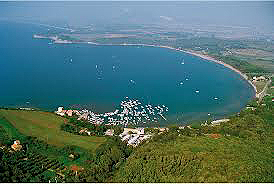 ..
..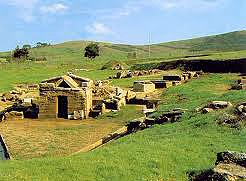 ..
..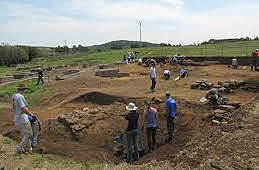
*
A project we are currently working on
involves the

Now we are raising money to catalog and exhibit the collection. If you love Vaudeville and want to contribute to the preservation of this collection send your tax deductible contribution to Special Collections, University of Arizona Libraries, PO Box 210055, Tucson, AZ 85721-0055 or click here for contact information to find out more!

Some Recent Photos
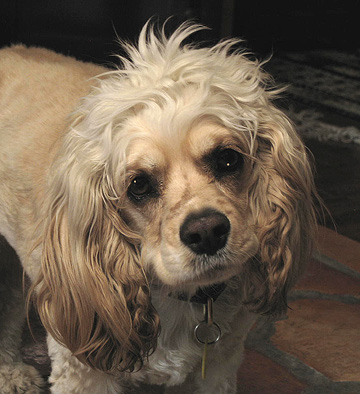
Lovely Lana in 2010 at her second birthday...
"The Talkies Come to Town"
On February 27, 2009 David was the Emcee of a fund raiser to raise money for the new Vaudeville Museum at the University of Arizona. It was held at the historic Fox Theatre in Tucson. The evening was called "The Talkies Come to Town" and featured several restored Vitaphone shorts from UCLA Film and Television Archives and Warner Brothers provided by Dudley Heer of the Vitaphone Project. Frank Cullen, one of the founders of the original Vaudeville Museum in Boston and the donor, along with Mr. Donald McNeally, of the collection to the University of Arizona was there, as well as Dean Carla Stoffle, Dean of the UA Libraries and the Center for Creative Photography. The Vaudeville Collection is house in Special Collections at the University of Arizona Library.
David and I by the Fox ticket booth
A view of the beautiful ceiling of the restored Art Deco Fox in Tucson
We all had a great evening watching George Burns and Gracie Allen in "Lambchops", Van & Schenck in "The Pennant Winning Battery of Songland", Adele Rowland in "Stories in Song", Butler and Brennan in "You Don't Know the Half of It", Trixie Friganza in "My Bag of Trix", Shaw and Lee in "The Beau Brummels" and recently found footage from Gold Diggers of Broadway (1929) including the original "Tiptoe Through the Tulips" sequence. And all in the beautiful restored and wonderful Art Deco Fox Theatre. What a treasure that these bits of film history have been saved!
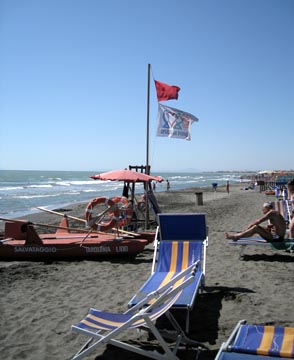 ...
...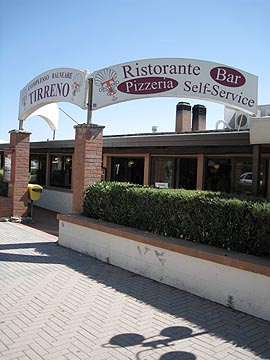 ...
...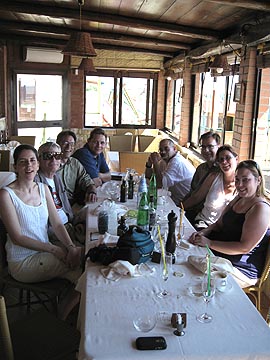
The beautiful beach at Tarquinia, Italy in 2009...and the WONDERFUL restaurant Tirreno... Lunch there with our colleagues, Christie and David Christiana, David Vandenburg, Claudio Bizzarri, Philip and Karen Zimmerman and Brittany Moore
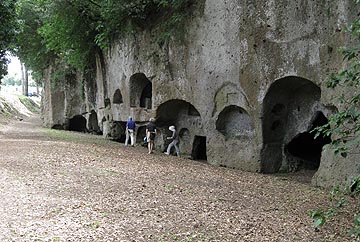 ..............
..............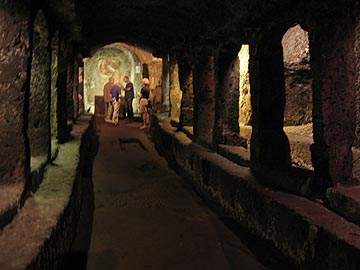
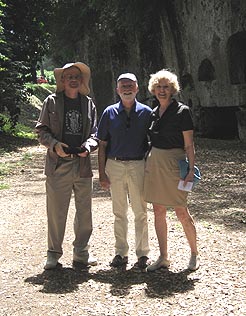
The fascinating site of Sutri..tombs carved out of the cliffs, and a view inside the famous Mithraeum..and David with our friends, Ray and Kate Frank
David recently taught a course on his early life in vaudeville for the Humanities Seminars at the University of Arizona.
In July, 2009, our beloved Angel succumbed to her bout with Cushing's Disease and left us. Please see our memorial page for Angel here. We were devasted and swore never to have another dog... until we saw the face of little Lana on a shelter website. We had to drive all the way to Phoenix to get her. She is a wonderful baby - just 10 months old. She is a pure bred Cocker - who would put a beauty like this in a shelter? She has the longest eye lashes I have ever seen - on a dog or a human!
 ......
......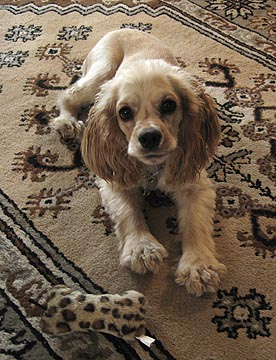 ......
......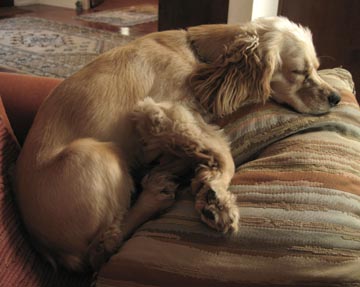
By the end of the year David finished his documentary "Forgotten Lives" , a pilot for PBS dealing with the lives of important people who made great contributions to us all but who have been forgotten or had credit for their advancements stolen by others.
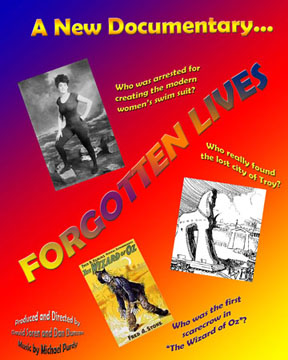
The pilot deals with the actual discoverer of the ancient site of Troy, the inventor of the womens' one-piece bathing suit and the man who created the part of the scarecrow in "The Wizard of Oz". Think you know the answers to these questions? I'll bet you are giving credit to the wrong people. Watch for this series to find out the truth...
In the summer of 2008 we stayed at the Casa al Duomo - right by the beautiful cathedral in Orvieto.
It has its own homepage!! You can read all about it here.
 .........
.........
On our Orvieto balcony

We had some wonderful trips to Tivoli, Perugia, Faleri Novi, Tarquinia and Rome... Here are some pictures...
 ......
......
The main fountain at the Villa d'Este at Tivoli... and an unusual view of the Canopus at Hadrian's Villa
 ......
......
Tomb of the Leopards 470 B.C. (left) and Tomb of the Lionesses 520 B.C.,
two of the fabulous Etruscan tombs at Tarquinia.
It's now possible to get this close to these and actually get pictures of them!!

At the beach at Tarquinia - some of the students built a "sand castle" of the ruins of Rome complete with the Coliseum!
 ......
......
The seldom-visited site of Faleri Novi...the main city gate ...and the amazing street lined with chamber tombs of the 4th-3rd C B.C. about a mile deep in the woods along the ancient Roman road, the Via Amerina

One of the tombs
 ......
......
As always our trips to Rome were filled with wonders - we took the students to the Forum and Palatine Hill (left - David is in the center in the big hat) and for historic walks looking for obscure features like the famous ancient street called the Argiletum that led through the Forum of Nerva and the area known as the Subura (right) ..it continues under the modern Via dei Fori Imperiali to the Forum.
 ......
......
The ruin of a primitive hut known as the hut of Romulus on the Palatine is the oldest part of Rome (left) ...east of the Palatine on the edge of the main street leading to the Arch of Constantine is the spot where the Septizodium stood. It was a huge decorative facade or possibly a fountain built by the Emperor Septimius Severus in 203 AD. It stood as impressive ruins until 1588 when Pope Sixtus V tore it down. Today a field of pink roses marks the outline of the Septizodium (right).
![]()
The Septizodium in the 16th Century before its destruction by the Pope
 ......
......
The remains of the Gardens of Sallust in the northwest part of Rome were originally at one of the lowest points in the city - at the base of a deep valley - today the city has been filled in and built up around the ruins (left) which remain deep down under street level. In central Rome the Church of S. Nicola in Carcere in the ancient Forum Holitorium or vegetable market was constructed within and over the ruins of three ancient temples - Janus, Spes and Juno Sospita. You can go under the church and see the remains of the ancient buildings well below modern street level (right - the podium of the Temple of Juno Sospita under the church).

The ancient Pons Fabricius, the oldest continually used bridge in Rome
According to Dio Cassius the bridge was built in 62 BC, the year after Cicero was consul, to replace an earlier wooden bridge destroyed by fire. It was commissioned by Lucius Fabricius, the curator of the roads and a member of the gens Fabricia of Rome. Completely intact from Roman antiquity, it has been in continuous use ever since. It connects the Tiber Island to the area of the Forum Boarium. An original inscription on the travertine commemorates its builder in elegant Roman capitals, L . FABRICIVS . C . F . CVR . VIAR | FACIVNDVM . COERAVIT | IDEMQVE | PROBAVIT . It is repeated four times: on each arch, on both sides of the bridge.

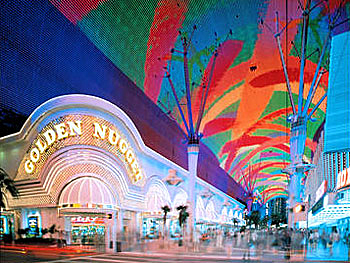
In 2008 I participated in the international convention of the Compact Collectors Club at the Golden Nugget in Las Vegas. I gave a Powerpoint presentation on one aspect of my collection - compacts with miniature paintings of known works of art.

Like this one depicting Rinaldo and Armida (a scene from Torquato Tassos's opera, Gerusalemme liberata of 1711) (1734) by François Boucher
I have put a version of it on this website and you can see it here.

David and Noelle in October, 2007.
Below is some information on our Fall 2007 trip to

We
arrived in


The Trattoria Etrusca
It was wonderful to see and meet all the students spending their semester in Orvieto at the Istituto Internazionale di Studi Classici di Orvieto, (http://www.officinecomunicazione.com/orvietoinstitute/ ). It was my first chance to use my new point-and-shoot Canon Powershot (as a photographer I have always been officially opposed to such things) and I LOVED it!!

David (left) with Alba Frascarelli (Administrative
Coordinator and Professor) and Claudio Bizzarri (Professor in Residence 2007)
from our Orvieto Institute

Some of the students at our Orvieto program this Fall.
By chance, Orvieto was holding its annual Slow Food Festival where people come from all over the world to savor local fare – it was a treat just to see the luscious local specialties arranged at the fair.

Have a free sample of luscious local
biscotti!

I can still smell the sausages sizzling!

An assortment of cheese, wine and salumi in
a store window in Orvieto
We spent one day on a trip with the students to historic
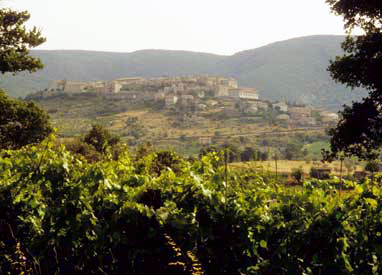
This is the hill town of Lugnano - the long large building on the right is the old winery that will become the new museum.
This is the town in Umbria where we
discovered the important 5th century A.D. infant cemetery a few
years ago that showed through groundbreaking DNA studies that malaria was a
factor in the decline of the Roman Empire. They've purchased a former winery and
want us to help select, design and install the exhibition there and be a guest
Curator. We are going to organize a museum in the winery and we have been asked
also to resume our excavations in the infant cemetery. We are considering that
now. The next day we traveled to Palestrina (ancient Praeneste) and the ruins
of Otricoli, once a large Imperial trade center. The town of


David and some students in the ruins of the sanctuary of Fortuna


In the ruins of the baths (left) and the theatre in Otricoli (ancient
Ocriculum) on the Via Flaminia, north of
After our stay in Orvieto we went to

In front of the Arch of Gallienus (the ancient Esquiline Gate)

I am standing on the spot (30 feet below me) where Julius Caesar was assassinated! That event occurred
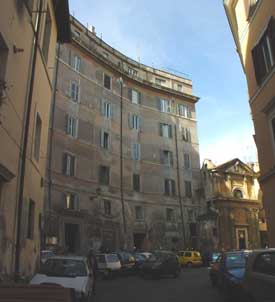
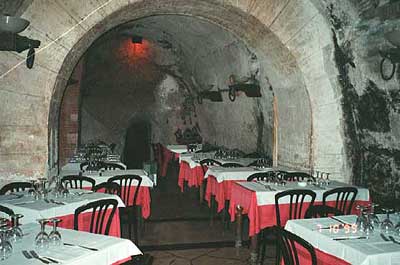

The statue of Giordano Bruno (one of my heroes) in the Campo dei Fiori
in
Here is an interesting comparison - it was David's idea!
 ***
*** ***
*** ***
***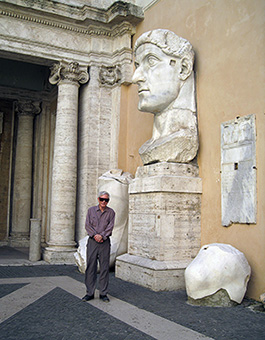
About 1970 .........................2000..................................2007............................2014
It only shows his hair getting grey - he weighs exactly the same! And Constantine never changes (except he is a little cleaner now)! I wish I had taken one every time we went to Rome!
Our time in
